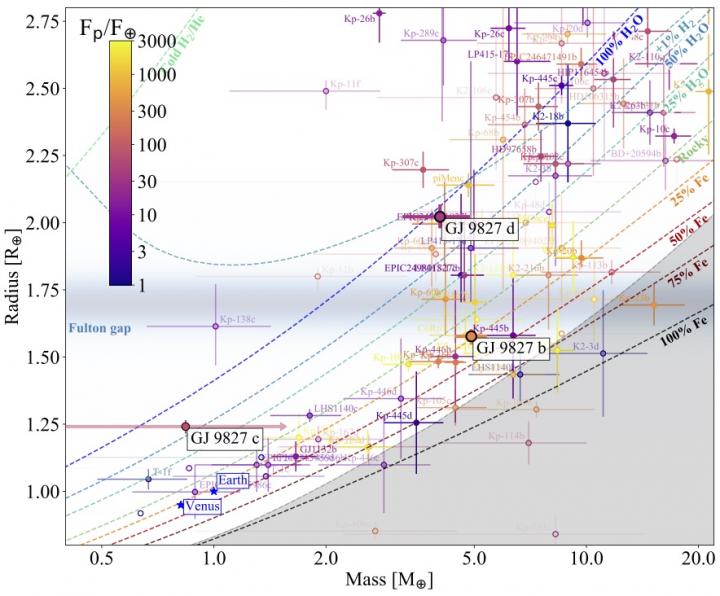The three super-Earths around GJ 9827
We use precise radial velocity measurements to estimate the masses of the super-Earths around GJ 9827. We find that two of these bracket the super-Earth radius gap and indicate that irradiation from the central star may have influenced the evolution of the inner planets in this system.
A recent paper led by a member of the Centre for Exoplanet Science carried out a detailed characterisation of the super-Earths around the star GJ 9827. Super-Earths are planets with radii slightly bigger than that of the Earth. GJ 9827 hosts 3 super-Earths, with radii of 1.6, 1.2 and 2 Earth radii and that have orbital periods of 1.2, 3.6 and 6.2 days respectively. The system was already known to host these 3 super-Earths and earlier studies had produced estimates of their radii and masses. We, however, had access to a large sample of data that allowed us to present quite precise mass, and compostion, estimates for 2 of the 3 super-Earths.

We used as yet unpublished radial velocity (RV) measurements from the HARPS-N spectrograph, together with already published RVs from HARPS-N, and additional RVs from other spectrographs. These spectrographs are able to measure stellar radial velocities to a precision of between 1 and 2 m/s. These RVs can then be used to infer the influence of the planets on their parent star and, consequently, can be used to infer the planet masses.
Our analysis indicates that GJ 9827 b (with a radius of 1.6 Earth radii) has a mass of 4.9 ± 0.5 Earth masses, while GJ 9827 d (with a radius of 2 Earth radii) has a mass of 4 ± 0.8 Earth masses. We couldn't contrain the mass of GJ 9827 c, but find that it is probably less than 1.5 Earth masses.
With both mass and radius estimates, we can also say something about these planets' internal compositions. This is illustrated by the figure on the right, which shows GJ 9827 b, c and d plotted on a mass-radius diagram, together with all other known exoplanets (in this mass and radius range) that have reliable mass and radius estimates.
The upper limit for GJ 9827 c's mass means we can't really say much about its composition. GJ 9827 b, on the other hand, is clearly rocky and probably has a composition similar to that of the Earth. However, GJ 9827 d, which has a similar mass to GJ 9827 b, almost certainly retains a substantial volatile envelope. It either has a low-mass hydrogen/helium atmosphere, or a substantial fraction of its mass is water.
This is particularly interesting, because there are indications that there is a gap in the radius distribution of super-Earth exoplanets. Exoplanets tend to have radii below about 1.5 Earth radii and are rocky, or they have radii above about 2 Earth radii and retain a substantial volatile atmposphere. The results of this analysis is consistent with this picture.
In addition, the planet that retains its atmosphere (GJ 9827 d) is also the one that is least heavily irradiated by the central star. This is consistent with a scenario in which super-Earths are typically born with a reasonably substantial atmosphere that can then be stripped from those that orbit very close to their parent stars.
The study of systems like GJ 9827 will help us to better understand the origin, and evolution, of small exoplanets and will also help us to constrain how stellar irradiation sculpts such populations. Understanding the origin of close-in rocky planets is an important step towards understanding the frequency of rocky planets that may orbit in regions where liquid water could exist on the planet's surface.
Links:
Rice, K., Malavolta, L., et al., Masses and radii for the three super-Earths orbiting GJ 9827, and implications for the composition of small exoplanets, Monthly Notices of the Royal Astronomical Society, in press, 2019.

